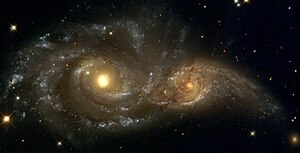NGC 2207 and IC 2163
| NGC 2207 / IC 2163 | |
|---|---|

|
|
| Observation data (J2000 epoch) | |
| Constellation | Canis Major |
| Right ascension | 06h 16m 22.0s / 06h 16m 28.0s |
| Declination | −21° 22′ 22″ / −21° 22′ 33″ |
| Redshift | 2741 ± 15 / 2765 ± 20 km/s |
| Distance | 81 ± 39 Mly (24.9 ± 12 Mpc) |
| Apparent magnitude (V) | 12.2 / 11.6 |
| Characteristics | |
| Type | SAB(rs)bc pec / SB(rs)c pec |
| Apparent size (V) | 4′.3 × 2′.8 / 3′.0 × 1′.2 |
| Notable features | colliding galaxies |
| Other designations | |
| RR132a / RR132b,PGC 018749 / 018751 | |
NGC 2207 and IC 2163 are a pair of colliding spiral galaxies about 80 million light-years away in the constellation Canis Major. Both galaxies were discovered by John Herschel in 1835. The larger spiral, NGC 2207, is classified as an intermediate spiral galaxy exhibiting a weak inner ring structure around the central bar. The smaller companion spiral, IC 2163, is classified as a barred spiral galaxy that also exhibits a weak inner ring and an elongated spiral arm that is likely being stretched by tidal forces with the larger companion. Both galaxies contain a vast amount of dust and gas, and are beginning to exhibit enhanced rates of star formation, as seen in infrared images. So far, four supernovae have been observed in NGC 2207:
NGC 2207 is in the process of tidally stripping IC 2163.
NGC 2207 is in the process of colliding and merging with IC 2163. But unlike the Antennae or the Mice Galaxies, they are still two separate spiral galaxies. They are only in the first step of colliding and merging. Soon they will collide, probably looking a bit more like the Mice Galaxies. In about a billion years time they are expected to merge and become an elliptical galaxy or perhaps a disk galaxy.
Ocular structures like these tend to only last for several tens of millions of years.
An infrared Spitzer Space Telescope image of NGC 2207 and IC 2163. Credit: NASA/JPL.
...
Wikipedia
